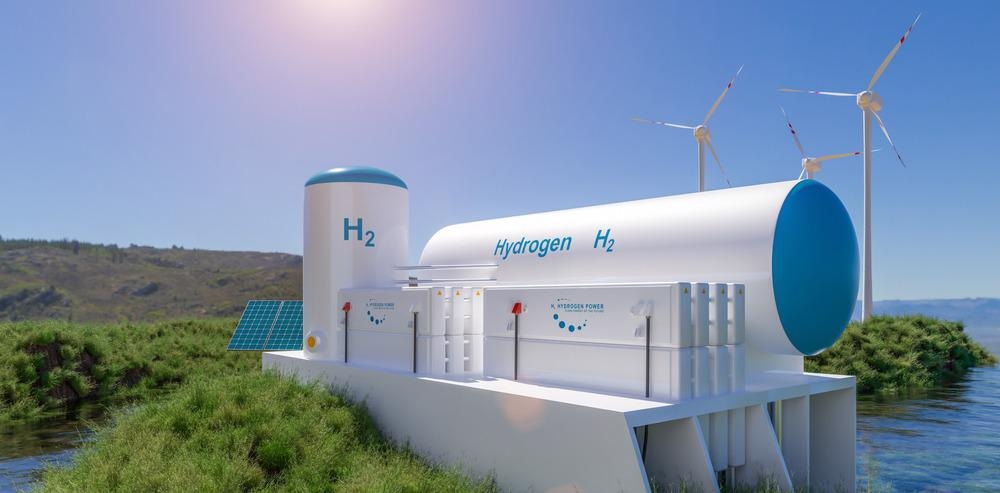Clean hydrogen is a versatile energy carrier and feedstock that has the potential to transform and decarbonize many industries. It is created via electrolysis, which uses electricity to split water into hydrogen and oxygen, or by reacting fossil fuels with steam or controlled amounts of oxygen. It can aid decarbonization if it is produced with low- or zero-emission sources.

Image Credit: Alexander Kirch /Shutterstock.com
Australia can build an economically sustainable domestic and export hydrogen industry. Hydrogen could replace natural gas as a low emission source of heat and electricity, and in transport. It can also be used as a cost-competitive feedstock for ammonia, chemicals, petrochemicals, synthetic fuels, glass manufacture, and metal processing.
What is Clean Hydrogen?
There are many types of hydrogen, each denoted by a different color depending on how they are produced.
At one end of the scale is black and brown hydrogen, which uses black coal in the hydrogen-making process and is the most environmentally damaging. Blue hydrogen is produced from natural gas using steam reforming, while grey hydrogen, the most common form of hydrogen production, is created from natural gas or methane, using steam methane reformation (SMR).
At the other end of the spectrum is hydrogen produced through cleaner and more environmentally friendly means, specifically electrolysis. Electrolysis is an electrochemical reaction that splits water into hydrogen and oxygen, emitting zero-carbon dioxide in the process.
Pink hydrogen is generated through electrolysis powered by nuclear energy while yellow hydrogen, a relatively new variety, creates hydrogen through electrolysis using solar power.
Green hydrogen is produced via electrolysis with low- or zero-emission electricity, so no harmful greenhouse gas emissions. It is made using clean electricity from surplus renewable energy sources, such as solar or wind power.
Clean hydrogen only makes up a small percentage of the overall hydrogen, because it is expensive to produce, but it is expected that the price will come down as it becomes more common, just as we have seen with other technologies.
CSIRO’s Roadmap
The National Hydrogen Roadmap developed by CSIRO, Australia’s National Science Agency, serves as a blueprint for the development of the hydrogen industry within the country. It aims to quantify the economic opportunities associated with the gas, and how these opportunities can be realized.
Its primary objective is to inform the next series of investments amongst stakeholders such as industry, government, and research so it can continue to be scaled in a coordinated manner.
There are already several mature technologies in the low emissions hydrogen value chain creating a pathway to an economically sustainable industry. While there is more research and development to be done, this level of sophistication means Australia is working towards market activation rather than technology development.
But there are barriers; these include a lack of supportive infrastructure and the cost of supplying hydrogen. These can both be overcome with strategic investments along the value chain from both the public and private sectors.
Although the hydrogen industry will be economically sustainable, it will need a jump-start from the government. It will also need heavy investment in infrastructure, hydrogen production, storage, and transport.
The roadmap shows that it will be necessary to assess the target price of hydrogen to ensure it is competitive compared with other energy carriers and feedstocks. The current state of the industry, i.e., the cost and maturity of the underpinning technologies and infrastructure, also needs to be considered.
Hydrogen Could Make its Mark
The roadmap identifies the material cost drivers and the key priorities and areas for investment in order to make hydrogen competitive in each of the identified markets. Hydrogen is unique in that it can simultaneously service multiple sources. For example, one hydrogen plant could secure agreements in a number of applications depending on the infrastructure, policy and demand.
One area in which hydrogen could make a valuable contribution is in managing the transition to a higher proportion of variable renewable electricity in the electricity network. This will help overcome the challenges associated with energy intermittency in the country and provide an opportunity to optimize renewable energy use. It will also have a role in protecting against supply shocks.
Another is as a feedstock for industry. The use of clean hydrogen as an industrial feedstock involves the direct displacement of hydrogen resulting from SMR (steam methane reformation) as the compulsory source of production. In this reaction, methane from natural gas is heated with steam and a catalyst to produce a mixture of carbon monoxide and hydrogen which is used in organic synthesis and as a fuel.
Hydrogen has been used in the petrochemical industry to treat and refine crude oil, but this has been declining in recent years because of Australia’s growing dependence on imported refined fuel products. However, to reduce this dependence and decarbonize the transport sector, hydrogen could be used in treating fuels derived from biomass.
Clean hydrogen as an input into ammonia and other chemicals such as methanol could renew demand for these products as the world transitions to a low-carbon economy.
Conclusion
The global market for hydrogen is expected to reach $155 billion by 2025 and should be able to compete well on a cost basis in applications such as transport and remote area power systems with tangible cost reductions by 2025.
The development of a hydrogen export industry is a great opportunity for Australia, which benefits from extensive natural resources, and could be a potential 'game changer' for the local industry and the broader energy sector.
References and Further Reading
CSIRO (2021) National Hydrogen Roadmap CSIRO [online] https://www.csiro.au/
CSIRO (2021) National Hydrogen Roadmap, Executive Summary CSIRO [online] https://www.csiro.au/-/media/Do-Business/Files/Futures/18-00314_EN_NationalHydrogenRoadmap_ExecutiveSummary_WEB_180815.pdf
National Grid (2021) The Hydrogen Colour Spectrum National Grid [online] https://www.nationalgrid.com/stories/energy-explained/hydrogen-colour-spectrum
Disclaimer: The views expressed here are those of the author expressed in their private capacity and do not necessarily represent the views of AZoM.com Limited T/A AZoNetwork the owner and operator of this website. This disclaimer forms part of the Terms and conditions of use of this website.